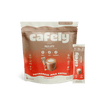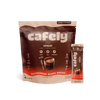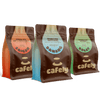Your morning coffee does more for your health than providing a pick-me-up. There are several key health benefits across all types of coffee. But with so many choices, what is the best choice for your health?
In this read, we discuss some of the potential health benefits of coffee and give you tips on choosing the best healthy coffee.
How to Choose the Best Healthy Coffee
Finding the healthiest coffee is about more than calories, sugar, and fat content.
Here are some key factors to look for when selecting the best healthy coffee:
- Organically Grown — Organic growing practices have a better environmental impact than traditional methods. Organic coffee also contains fewer pollutants from chemical pesticides, fungicides, and fertilizers, making it a healthier option.
- Certified Mold-Free — Mycotoxins (toxins from mold) may cause cancer, and respiratory issues, and reduce immune function. To ensure your coffee is free from harmful mycotoxins, look for a mold-free certification when buying.
- Sugar-Free — Adding sugar to coffee at any stage increases the calorie count and the impact on your health. If you’re looking for healthy coffee, opt for naturally sweetened blends or dark roast beans that are sweeter by nature.
- Freshly Roasted — Getting recently roasted coffee is the best way to ensure it has great flavor. It also ensures that the coffee hasn’t spent weeks or months in storage, where it could potentially be damaged or contaminated.
- Freshly Ground — When coffee is ground, the surface area is increased. Ground coffee goes stale quicker — potentially losing beneficial antioxidants.
- Bean Type — Both arabica and robusta beans have their benefits. For plenty of natural sweetness, opt for arabica beans. For a potent caffeine kick, opt for robusta beans. Both types still have plenty of antioxidants and micronutrients.
Potential Health Benefits of Coffee

Coffee may have several health benefits, and researchers are exploring specific ways it may impact our bodies.
Here are the key health-boosting benefits of coffee:
1. Coffee Boosts Energy Levels
Perhaps the most obvious benefit of coffee is its energy-boosting properties. Coffee contains caffeine — a stimulant. It's one of the main reasons why coffee is so widely consumed. To maximize this benefit, start by using only the best coffee for energy boost. The right coffee can help you stay more alert, focused, and productive throughout the day, without the jitters or caffeine crashes.
The caffeine in coffee wakes you up by interacting with adenosine — a chemical that induces “tiredness.” In the brain, this chemical is an inhibitory neurotransmitter. When your body detects it, you start to feel sleepy.
Caffeine blocks adenosine receptors so that the adenosine cannot bind to them. In essence, it temporarily blocks your brain from feeling tired [1].
2. Coffee May Protect Against Type 2 Diabetes
Coffee shows promise in protecting people against type 2 diabetes.
A review of scientific studies discovered that people who consumed one cup of coffee per day had a 6% reduction in the chance of developing type 2 diabetes [2]. However, more research is required to understand why and how the best coffee for diabetes reduces its risk until we can be certain of its preventative qualities.
3. Coffee May Have Neuroprotective Properties
Some researchers, scientists, and doctors believe that coffee has neuroprotective properties — meaning it can potentially protect you against Alzheimer's, Parkinson's, and other neurological diseases.
A good proportion of studies found that coffee could protect against certain neurodegenerative conditions. For example, one review of thirteen studies found that people who regularly consume caffeine have a significantly lower risk of developing Parkinson’s disease. The review also found that caffeine consumption slowed the progression of Parkinson’s over time [3].
4. Coffee Has Antioxidant Properties
Coffee contains a high proportion of chlorogenic acid — a powerful antioxidant [4]. Antioxidants interact with chemicals in our bodies called free radicals, which are unstable and can cause oxidative stress over time.
Oxidative stress in the body can lead to cell damage, early aging, diabetes, and cancer. The antioxidants in coffee could prevent these effects.
5. Coffee May Boost Your Mood
Researchers have studied the relationship between coffee, caffeine, and a person’s mood for years. While some studies vary, they largely find that coffee — when moderately consumed — leads to increased alertness and improved performance on both simple and choice-based tasks [5].
Additionally, various studies have found a link between the consumption of coffee and caffeine and a decreased risk of depression [6].
The Healthiest Way to Drink Your Coffee
Let’s run through some health-conscious ways you can boost your coffee without sacrificing flavor and experience:
- Opt for naturally sweeter coffee blends, like dark-roasted arabica beans. The less bitter the coffee, the less sugar you’ll need.
- Choose naturally sweetened coffee blends. Naturally sweetened products can give you the same sweetness as sugar, without the potential negative impacts on health.
- Add a pinch of salt to your coffee instead of sugar. This may sound unusual, but it can cut the bitterness of the drink and — in small amounts — may be healthier than sugar.
- Change the type of milk you drink. Even a small change, such as from full-fat to skim milk, can drastically reduce the amount of fat in your diet.
- Swap your drink for a less milky version. Swapping a latte for a macchiato will give you a drink that’s similar in flavor but has less milk overall.
- Ensure you drink plenty of water as well as coffee. Caffeine is a mild diuretic (can make you dehydrated), so drinking more water can help you stay hydrated when drinking coffee.
Are Dark Roasts or Light Roasts Healthier?

There’s a lot of talk about the relative healthiness of dark and light roast coffee, especially because beans can lose certain phytochemicals to evaporation during the roasting process.
Here are some key features to consider when choosing between dark and light roasts for health:
Dark Roasts Contain More PAHs
Polycyclic aromatic hydrocarbons (PAHs) are a chemical product of combustion. It’s commonly found in many foods and drinks, including dark roast and French roast coffee. Darker roasts may have up to four times more PAHs than light roasts.
Though there are links to this chemical causing cancer, it’s not all bad news — there are not as many PAHs in coffee as would likely be dangerous to consume [7].
For example, one particular PAH called benzopyrene is considered the most toxic and carcinogenic PAH there is. However, the maximum amount of benzopyrene in an average cup of coffee is less than a nanogram — a portion of grilled chicken may have around a thousand times this amount [8,9].
Dark Roasts Have More Antioxidants
Generally, the amount of antioxidants in coffee varies largely by where the beans are grown. However, one study found that darker roasts had more antioxidants than light roasts [10].
The main reason for this is that chemical compounds generated during roasting have more additional antioxidant properties to the natural properties of the beans themselves.
If you want coffee with higher antioxidant content, then try some of the best dark roast coffee options online.
Light Roasts Have More Chlorogenic Acids
There is also evidence that coffee's chlorogenic acids can become less present throughout a longer roasting time [11]. Chlorogenic acids have several health benefits — it’s believed to be responsible for the neuroprotective qualities of coffee [12]. If you’re looking for coffee that supports brain health and overall wellness, the best light roast coffee may offer a flavorful and health-conscious option.
FAQs: Health Benefits of Coffee
Want to learn more about the health benefits of coffee?
Read through the answers to the FAQs below:
1. What’s the Main Way Coffee Is Healthy?
Coffee can be healthy in many ways. For instance, it has a high antioxidant content, especially in dark roasts [10]. It has also been shown to have neuroprotective qualities [12].
2. Why Aren’t the Benefits of Coffee Stated Medically?
Many of coffee’s health benefits are considered “suspected” because more research on human subjects is required. For instance, it’s a regularly repeated “fact” that coffee can lead to a reduction in the chances of a person developing type 2 diabetes. However, many scientists and diabetes experts still debate this [2].
3. How Can You Ensure Your Coffee Is As Healthy As Possible?

To ensure your coffee is as healthy as possible, avoid adding a lot of fat and sugar in the form of cream and syrups. You should also opt for coffee that’s organically grown, certified mold-free, and freshly roasted.
4. Does Coffee Hydrate You?
In smaller quantities, yes, coffee does hydrate you. However, caffeine is also a diuretic, meaning that a larger dose of coffee and caffeine could make you urinate more, leading to an overall decrease in hydration.
5. Are Dark Roasts or Light Roasts Healthier?
Both dark and light roast coffees may be healthy for you, just in different ways. Dark roasts contain more antioxidants [10]. Lighter roasts contain more chlorogenic acids, which is the main chemical responsible for coffee’s suspected neuroprotective properties [11,12].
6. Is Vietnamese Coffee Healthy?
Plain Vietnamese-grown coffee is just as healthy as any other type of coffee beans. Traditional Vietnamese coffee is roasted with butter, which may increase the fat content. However, this is likely not a very large increase and could limit the need for milk or creamer thanks to the velvety quality it gives the final cup.
Vietnamese coffee, a beverage that mixes espresso with condensed milk and 40% to 45% sugar, is certainly not healthy. But it is quite delicious and can be a great calorie booster.
7. How Much Coffee Should I Drink to Stay Healthy?
No hard number would work for everyone to answer this question. However, the maximum amount of caffeine anyone should have in a day is 400 mg — typically in three to four average cups of coffee.
8. How Many Calories Are in a Cup of Coffee?
A cup of black coffee has around two calories per 8 oz cup. However, the same coffee with one tablespoon of half-and-half and one teaspoon of sugar contains 38 calories in the same portion. A highly caloric drink like bulletproof coffee can contain roughly 325 calories in the same volume.
References
- Institute of Medicine (US) Committee on Military Nutrition Research. (2001). Caffeine for the Sustainment of Mental Task Performance: Formulations for Military Operations. National Library of Medicine; National Academies Press (US).
- Carlström, M., & Larsson, S. C. (2018). Coffee consumption and reduced risk of developing type 2 diabetes: a systematic review with meta-analysis. Nutrition reviews, 76(6), 395–417.
- Hong, C. T., Chan, L., & Bai, C. H. (2020). The Effect of Caffeine on the Risk and Progression of Parkinson's Disease: A Meta-Analysis. Nutrients, 12(6), 1860.
- Yashin, A., Yashin, Y., Wang, J. Y., & Nemzer, B. (2013). Antioxidant and Antiradical Activity of Coffee. Antioxidants, 2(4), 230.
- Brice, C. F., & Smith, A. P. (2002). Effects of caffeine on mood and performance: a study of realistic consumption. Psychopharmacology, 164(2), 188–192.
- Wang, L., Shen, X., Wu, Y., & Zhang, D. (2015). Coffee and caffeine consumption and depression: A meta-analysis of observational studies. Australian & New Zealand Journal of Psychiatry, 50(3), 228–242.
- Jimenez, A., Adisa, A., Woodham, C., & Saleh, M. (2014). Determination of polycyclic aromatic hydrocarbons in roasted coffee. Journal of environmental science and health. Part. B, Pesticides, food contaminants, and agricultural wastes, 49(11), 828–835.
- De Kruijf, N., Schouten, T., & Van der Stegen, G. H. D. (1987). Rapid determination of benzo[a]pyrene in roasted coffee and coffee brew by high-performance liquid chromatography with fluorescence detection. Journal of Agricultural and Food Chemistry, 35(4), 545–549.
- Kazerouni, N., Sinha, R., Hsu, C. H., Greenberg, A., & Rothman, N. (2001). Analysis of 200 food items for benzo[a]pyrene and estimation of its intake in an epidemiologic study. Food and chemical toxicology : an international journal published for the British Industrial Biological Research Association, 39(5), 423–436.
- Dybkowska, E., Sadowska, A., Rakowska, R., Dębowska, M., Świderski, F., & Świąder, K. (2017). Assessing polyphenols content and antioxidant activity in coffee beans according to origin and the degree of roasting. Roczniki Panstwowego Zakladu Higieny, 68(4), 347–353.
- Awwad, S., Issa, R., Alnsour, L., & Albals, D. (2021). Quantification of Caffeine and Chlorogenic Acid in Green and Roasted Coffee Samples Using HPLC-DAD and Evaluation of the Effect of Degree of Roasting on Their Levels. Molecules, 26(24), 7502.
- Pawar, S. H., Upganlawar, A. B., & Upasani, C. D. (2023). Therapeutic benefits of phenolic acids in peripheral neuropathy. Elsevier EBooks, 753–771.










